Journey through biblical texts to uncover the enigmatic significance of blood moons in prophecy—what secrets do they hold?

Blood Moon Scriptures in the Bible
The moon turns to blood, the earth shivers, and humanity watches in awe; these vivid images aren't just elements of a dramatic narrative, they're deeply rooted in biblical scriptures.
As you explore the Prophecy of Joel, Peter's sermon in Acts, and the Revelation to John, you'll find that blood moons are more than mere celestial events—they're symbols laden with meaning, woven into the fabric of biblical prophecy.
But what exactly do these scriptures tell us about blood moons, and why have they captivated the human imagination for centuries?
Join the conversation, and let's uncover the mysteries that lie behind these intriguing biblical references.
Key Takeaways
- The Prophecy of Joel and Peter's Sermon in Acts reference Blood Moons as signs preceding the end times.
- Blood Moons symbolize judgment, redemption, and cosmic conflicts within biblical prophecy.
- Revelations depict Blood Moons as celestial signs marking significant eschatological events.
- Interpretations of Blood Moons vary among scholars, linking them to times of transformation or divine judgment.
The Prophecy of Joel
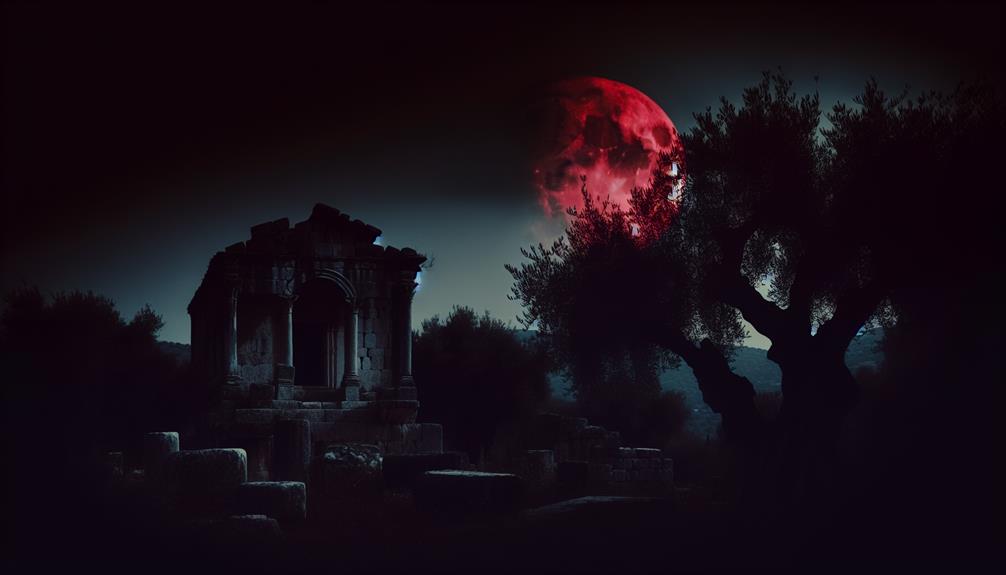
In the Book of Joel, specifically in chapter 2, verses 30-31, the prophecy vividly describes a time when 'the sun will be turned to darkness and the moon to blood,' signaling significant, apocalyptic events. Joel's context, deeply rooted in an agrarian society, gives this prophecy a layered significance. The agricultural implications are profound, as both sun and moon play critical roles in farming cycles. You'll find that understanding Joel's context enriches your grasp of the prophecy's depth.
Joel's era was characterized by a heavy reliance on agricultural success for societal well-being. A blood moon, therefore, wasn't just a sign of apocalyptic change but also a direct threat to the livelihood of Joel's community. This dual meaning underscores the prophecy's urgency and the immediate peril it represented to its original audience.
Scholars argue that the metaphorical language used by Joel—referencing celestial events like blood moons—served not only to forecast divine judgment but also to communicate the potential for agricultural disaster (Smith, 1989). This layering of meanings demonstrates Joel's adept use of imagery to resonate with his agrarian audience, for whom the cycles of the sun and moon were inextricably linked to survival.
Thus, when you delve into the prophecy of Joel, you're not just encountering an apocalyptic vision but also a poignant reflection on the vulnerability of agricultural society to cosmic and divine forces. This understanding of Joel's context and the agricultural implications of his prophecy provides a richer, more nuanced interpretation of these ancient texts.
Acts: Peter's Sermon
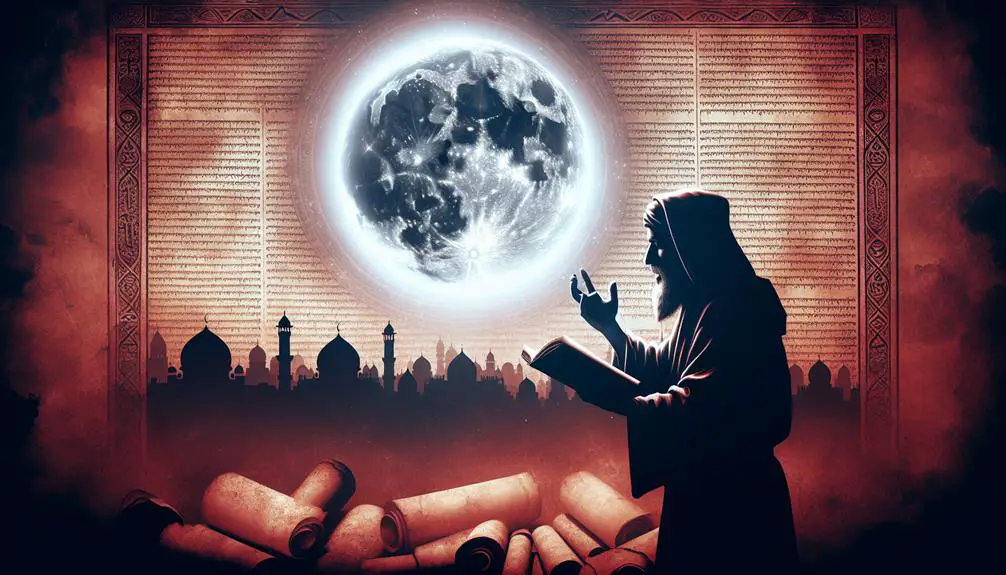
In Acts 2, Peter's sermon marks a pivotal moment in Christian scripture. He quotes Joel's prophecy, including references to a blood moon, to explain the events of Pentecost to his bewildered audience. This passage not only highlights the audience's reaction, ranging from skepticism to conversion, but also underscores the blood moon's significance as a herald of divine moments.
Scholars often debate the interpretative layers of Peter's use of Joel's prophecy. They suggest a complex interplay between apocalyptic imagery and the fulfillment of Old Testament promises.
Peter's Prophetic Quotation
During Peter's sermon, as recorded in Acts, he famously quotes a prophecy that vividly describes a blood moon, showcasing his deep understanding of its eschatological significance. Peter's role in this context is crucial; he serves as a bridge between ancient prophecies and their unfolding in the New Testament era.
His quotation from the book of Joel not only emphasizes the prophetic accuracy of scriptures but also underlines the immediacy of God's unfolding plan for humanity. Through Peter's discerning application of this prophecy, listeners are confronted with the tangible signs of divine intervention in their times.
His adept interpretation reveals a profound connection between celestial phenomena and theological truths, urging a reevaluation of the signs of times through a scripturally informed lens.
Audience Reaction to Sermon
Reflecting on Peter's adept use of prophecy, the audience's reaction to his sermon, as recorded in Acts, reveals a profound impact on both believers and skeptics alike, highlighting the sermon's power to elucidate and inspire. This moment intricately captures sermon dynamics and congregational feedback, pivotal for understanding early Christian engagement.
Aspect |
Impact |
|---|---|
Sermon Dynamics |
Peter's strategic incorporation of prophecy deeply resonates. |
Congregational Feedback |
Varying degrees of acceptance, sparking introspection and dialogue. |
Overall Effect |
A marked increase in believers, signifying the sermon's transformative potential. |
Analyzing these reactions provides insight into the sermon's ability to not only connect with the audience on a spiritual level but also to challenge and convert skeptics, showcasing the early church's dynamic approach to preaching and community building.
Blood Moon Significance
Peter's sermon masterfully employs the imagery of a blood moon, a significant event that resonates deeply with his audience, drawing from Joel 2:31 to underscore the prophetic nature of the times they're living in. This reference to lunar eclipses isn't merely an aesthetic choice. It's a scholarly nod to the profound impact astronomical phenomena have on theological interpretation.
The Revelation to John

How does the Revelation to John depict the phenomenon of the Blood Moon, and what theological implications does this imagery hold?
In the apocalyptic literature of the New Testament, the Book of Revelation presents vivid and symbolic imagery that has intrigued scholars and theologians for centuries. Particularly, the Blood Moon serves as a celestial sign, woven into the narrative of the end times. This imagery isn't merely for dramatic effect but carries deep theological significance, reflecting on the cosmic battle between good and evil, judgment, and redemption.
The narrative of the Seven Seals, as detailed in Revelation, introduces the Blood Moon under a context of divine wrath and judgment. The opening of the sixth seal triggers a series of cataclysmic events, among which the moon becomes 'like blood' (Revelation 6:12). This celestial phenomenon isn't isolated but is part of a broader tableau that includes earthquakes, the darkening of the sun, and the falling of stars. The imagery of the Blood Moon in this context symbolizes the impending judgment and the profound transformations the world undergoes in response to the Dragon's Wrath. The Dragon, representing evil forces opposing the divine, incites a cosmic disturbance that the Blood Moon emblematically signals to humanity.
Analytically, the Blood Moon serves as a harbinger of change, a divine signal to humanity of the forthcoming trials and the ultimate triumph of good over evil. Its occurrence within the apocalyptic narrative underscores the inevitability of divine judgment and the importance of readiness and faithfulness amidst tribulations. This celestial sign, thus, transcends its astronomical occurrence, embodying theological themes of warning, judgment, and redemption in the cosmic drama of Revelation.
The Significance of Blood Moons
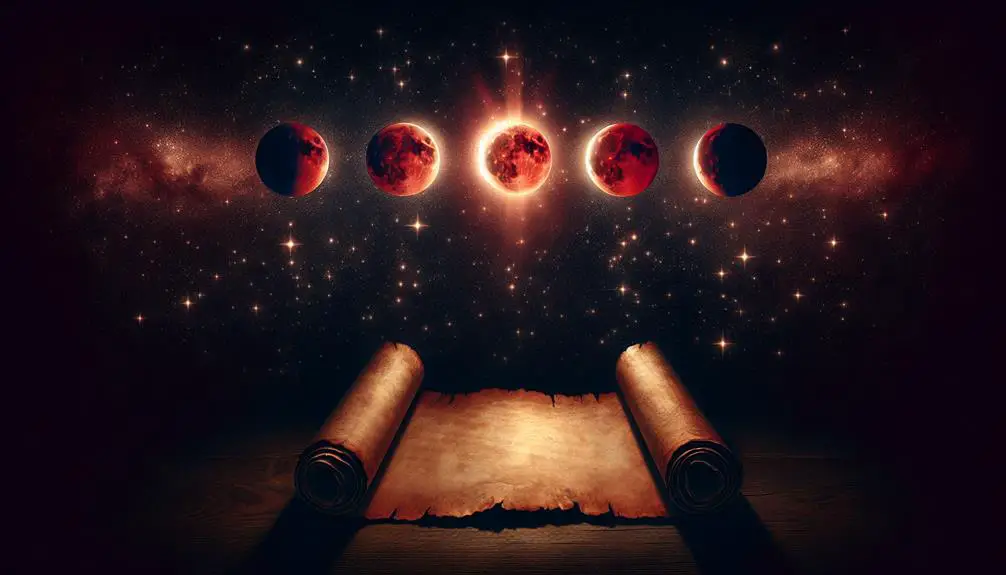
Throughout history, Blood Moons have captivated scholars and theologians alike, serving as a potent symbol in biblical prophecy and eschatological studies. These lunar eclipses, fascinating astronomical events, aren't just celestial phenomena; they're imbued with deep theological significance, seen by many as harbingers of significant spiritual shifts or divine messages.
When you delve into the scriptures, you'll find that Blood Moons are frequently associated with pivotal moments in biblical narrative, suggesting a divine orchestration of cosmic events to signal earthbound changes. The appearance of a Blood Moon is often interpreted as a sign from God, marking times of profound transformation, judgment, or renewal.
To better comprehend their significance, consider these aspects:
- Symbolism: Blood Moons symbolize blood, fire, and pillars of smoke; elements often associated with divine judgment or the presence of God.
- Timing: Their occurrence during Jewish feasts has led many to speculate about their connection to God's calendar and the fulfillment of prophecies.
- Interpretation: Scholars and theologians interpret Blood Moons through a mix of astronomical knowledge and scriptural insights, seeking to understand God's messages.
- Signs: In eschatology, they're seen as signs preceding significant events, including the end times as depicted in the Book of Revelation.
In essence, Blood Moons serve as a bridge between the celestial and the terrestrial, reminding you of the interconnectedness of physical astronomical events and spiritual truths. They invite a reflective pause, urging you to consider the broader, perhaps divine, implications of these stunning natural occurrences.
Historical Blood Moon Events
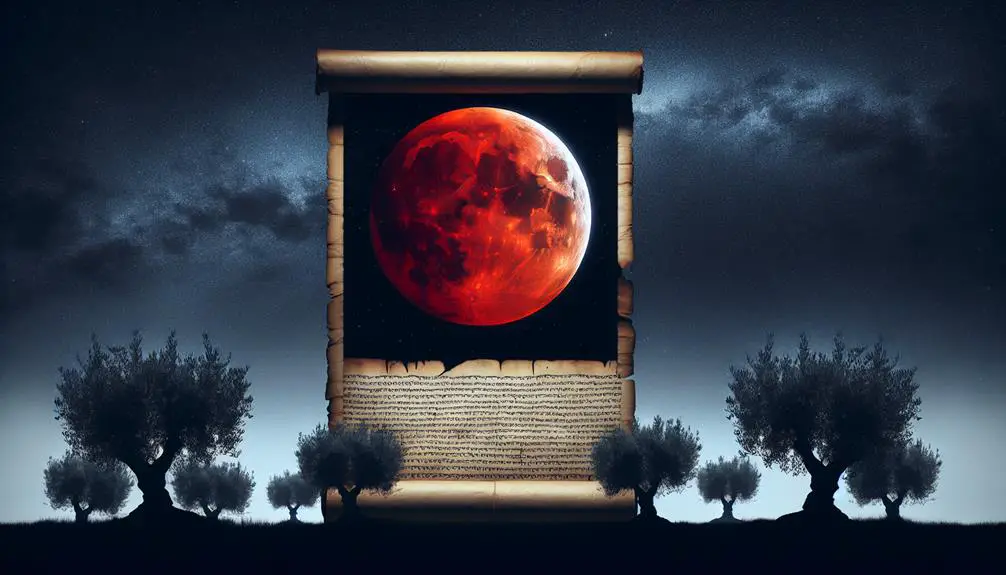
Reflecting on the theological significance of Blood Moons, it's crucial to explore specific historical events where these celestial phenomena have played a pivotal role in shaping religious and cultural narratives. Lunar eclipses, which give rise to the visually striking Blood Moons, have been documented and interpreted throughout history, often with profound religious and cultural implications.
From an astronomical standpoint, Blood Moons occur during a total lunar eclipse when the Earth positions itself directly between the Sun and the Moon. This alignment causes the Earth's shadow to block the Sun's light, which otherwise reflects off the Moon. The refracted light passing through Earth's atmosphere gives the Moon a reddish tint, leading to the term 'Blood Moon.' This natural explanation, however, didn't prevent ancient and medieval societies from attributing these events to divine messages or omens.
Historically, recorded lunar eclipses that coincided with significant religious or cultural events have often been retrospectively branded as Blood Moons. For example, the lunar eclipse of 413 BC, recorded by ancient Greek historians, was interpreted as an ominous sign, influencing military strategies during the Peloponnesian War. Similarly, medieval chronicles occasionally linked lunar eclipses with major religious events, suggesting a divine connection.
These historical interpretations demonstrate the rich tapestry of meanings attributed to Blood Moons over the centuries. While modern astronomy provides clear explanations for the phenomenon, the historical events associated with lunar eclipses reveal a fascinating intersection between human belief systems and the natural world. Understanding these events helps to appreciate the complex ways in which celestial phenomena like Blood Moons have influenced human history and culture.
Interpretations Across Cultures
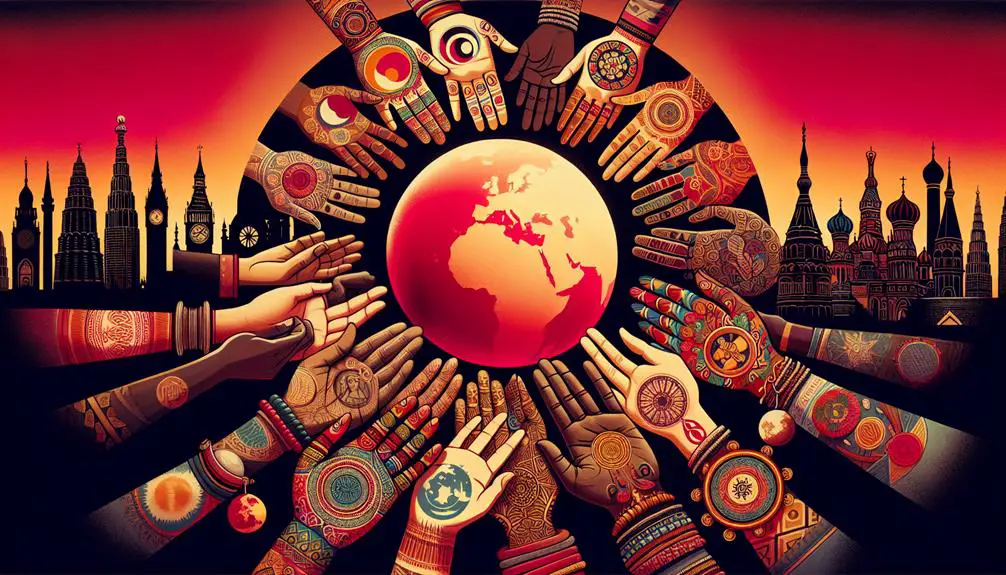
You'll find that interpretations of the Blood Moon in the Bible have resonated differently across cultures, each embedding unique symbolism and myths into their collective consciousness. Scholars such as M. K. Healey (2018) have emphasized this variance, noting how global myths can both diverge significantly and converge in surprising ways around celestial events like blood moons.
In examining cultural symbolism and exploring global myths, you're engaging with a rich tapestry of human belief and narrative that illuminates our shared yet diverse interpretations of the cosmos.
Cultural Symbolism Comparison
The interpretation of Blood Moon scriptures varies widely across cultures, each embedding unique symbolic meanings into this celestial phenomenon. Artistic representations and lunar festivals are pivotal in understanding these cultural interpretations.
- Artistic Representations: Across cultures, artists have depicted Blood Moons in various contexts, from harbingers of doom to symbols of renewal. These depictions are deeply entrenched in the societal beliefs and historical events of the time.
- Lunar Festivals: Many societies host festivals during lunar events, including Blood Moons. These festivals often blend astronomical phenomena with cultural narratives, celebrating the moon's influence on agricultural cycles and human life.
- Symbolic Meanings: In some cultures, a Blood Moon symbolizes change or transition, while in others, it's seen as an omen.
- Historical Contexts: Historical events occurring during Blood Moons can influence a culture's interpretation, linking them to prophecy or significant change.
This analysis reveals the depth and variance in cultural symbolism attached to Blood Moons, highlighting the complex interplay between celestial events and human interpretation.
Global Myths Explored
Building on the understanding of cultural symbolism, let's explore global myths that offer diverse interpretations of Blood Moons across cultures. These celestial events have historically been linked to lunar deities and astronomical phenomena, creating a rich tapestry of beliefs and stories.
For instance, in many cultures, Blood Moons are seen as omens, often tied to the wrath or messages from gods. The Maya civilization, deeply versed in astronomical phenomena, interpreted Blood Moons through the lens of their lunar goddess, Ix Chel, associating it with fertility and rebirth.
Similarly, in Norse mythology, a Blood Moon was thought to forewarn of significant world events, encapsulating the essence of change. These interpretations, deeply rooted in the observation of lunar deities and celestial movements, showcase humanity's quest to find meaning in the skies above.
Modern Views on Biblical Moons

In recent years, scholars and theologians have increasingly analyzed the significance of biblical moons, offering new interpretations that challenge traditional views. A focal point of this discussion has been the astronomical significance of lunar eclipses mentioned in scripture. You're likely familiar with the vivid imagery of blood moons in the Bible, but modern analysis has expanded our understanding of these celestial events beyond mere omens or prophetic signs.
Here are a few key insights from contemporary scholarship:
- Astronomical Events as Historical Markers: Researchers now view biblical references to lunar phenomena not just as symbolic, but also as potential historical markers. These celestial events could help date certain biblical narratives more accurately.
- Symbolism and Metaphor: While acknowledging the astronomical accuracy, modern scholars also delve into the symbolic meanings behind the descriptions of moons and eclipses, exploring how these served to convey deeper theological or moral messages to ancient audiences.
- Cross-Cultural Comparisons: By comparing biblical accounts with other ancient civilizations' interpretations of lunar eclipses, scholars have uncovered broader human attempts to understand and ascribe meaning to the cosmos.
- Scientific and Theological Intersection: There's a growing appreciation for how ancient peoples integrated their observations of the sky with their spiritual beliefs, suggesting a more nuanced relationship between faith and science than previously thought.
This reevaluation hasn't only enriched our understanding of biblical texts but also highlighted the interconnectedness of astronomical, historical, and theological knowledge in ancient times. As you delve deeper into the scriptures, consider how modern perspectives on biblical moons can illuminate your understanding of these ancient texts.
Frequently Asked Questions
How Do Scientific Explanations of Blood Moons Align or Conflict With Biblical Descriptions?
When you explore how lunar eclipses' science aligns or conflicts with biblical descriptions, you're diving into a fascinating area. Scientifically, a blood moon occurs due to sunlight filtering through Earth's atmosphere during an eclipse, not inherently apocalyptic.
However, biblical references often imbue these events with apocalyptic symbolism, suggesting a divine or ominous significance. This contrast highlights a divide between empirical observation and interpretative symbolism, inviting a deeper analysis of both perspectives.
Are There Any Lesser-Known Scriptures Outside of the Bible That Also Reference Phenomena Similar to Blood Moons?
Yes, there are lesser-known scriptures and texts outside the Bible that reference phenomena similar to blood moons. Ancient myths from various cultures are rich with celestial events, embodying deep cultural symbolism.
These stories often interpret lunar eclipses as omens or messages from the gods, mirroring the awe-inspiring nature of a blood moon. Exploring these texts provides a fascinating glimpse into how ancient societies understood and mythologized astronomical events.
How Have Blood Moons Been Depicted in Early Christian Art or Literature, if at All?
You might find that early Christian art or literature doesn't frequently spotlight blood moons. However, when they do appear in medieval iconography, they're often steeped in symbolic representation.
These depictions can serve as metaphors for divine omens or significant biblical events, reflecting the period's theological beliefs and artistic conventions.
Scholars suggest that such imagery invites deeper contemplation on the interplay between celestial phenomena and theological interpretation in medieval Christian thought.
What Role Do Blood Moons Play in Contemporary Religious Practices or Beliefs Outside of Christianity?
You're diving into a world where the moon bleeds mystery into the night sky. Outside Christianity, blood moons are celestial spectacles wrapped in lunar festivals and astrological significance.
They're not just astronomical events; they're mystical markers, guiding various religious practices. From illuminating pagan rituals to enriching Hindu festivals, these crimson moons are a canvas for the divine, intertwining the celestial with the terrestrial in a dance of cosmic synchronicity.
Have There Been Any Significant Shifts in the Theological Interpretation of Blood Moons Within Various Christian Denominations Over the Centuries?
You've asked about shifts in the interpretation of blood moons within Christianity.
Over centuries, ecclesiastical debates have evolved, with no singular denominational consensus emerging.
Early interpretations often linked these celestial events to prophecy, but modern perspectives vary, reflecting broader theological trends and scientific understanding.
This divergence illustrates the dynamic nature of religious interpretation, highlighting how context, culture, and knowledge shape our understanding of phenomena historically viewed through a religious lens.
Conclusion
In delving into the celestial tapestry of the Bible, you've journeyed through ancient prophecies and modern interpretations, witnessing how blood moons weave through the fabric of spiritual narratives.
These astronomical events, acting as harbingers of significant earthly and heavenly shifts, mirror the complexity of interpreting divine signs.
As you reflect on the varied cultural and theological lenses, remember, the sky isn't just a canvas for celestial phenomena but a mirror reflecting humanity's quest for understanding and connection.

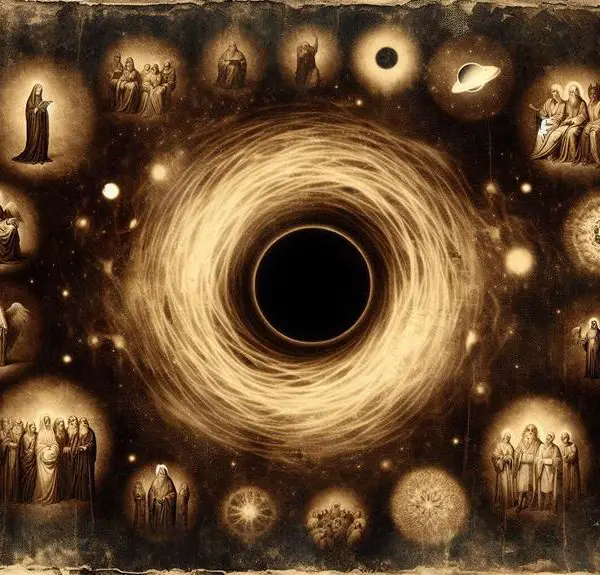

Sign up